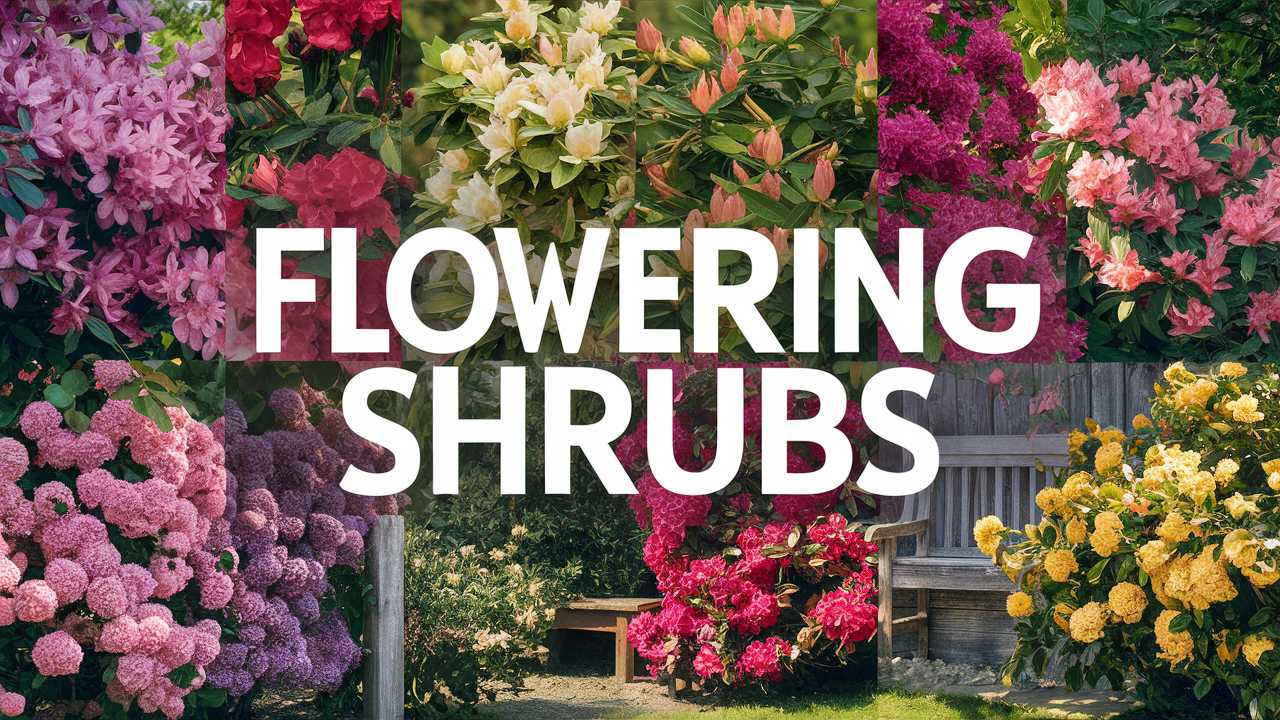In this guide, we will explore a diverse array of flowering shrubs, their characteristics, and how they can enhance your gardening experience.
Camellia (Camellia Spp.)
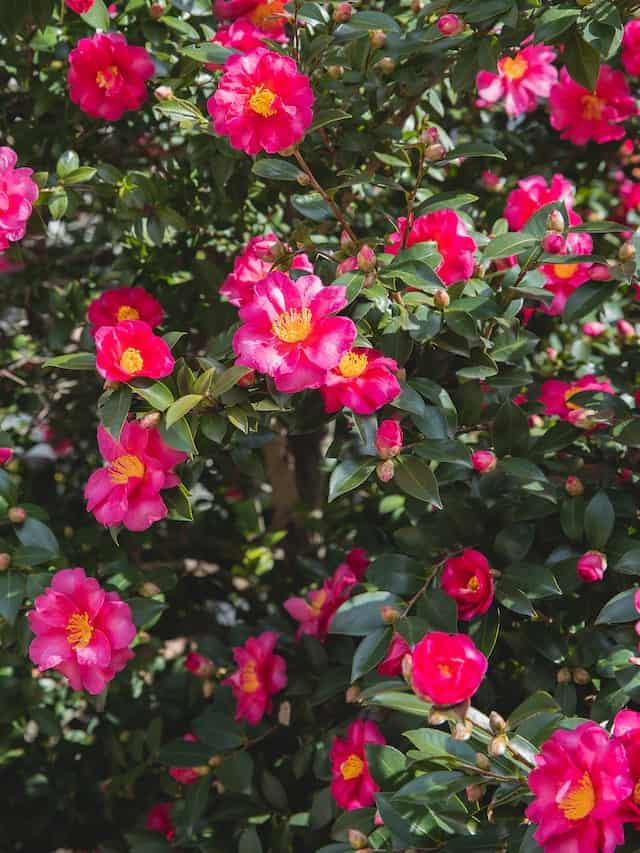
Camellias are revered for their stunning blooms and glossy foliage. Native to Asia, these evergreen shrubs bloom from late winter to spring, making them a vital source of color when many other plants are still dormant. Depending on the species, camellias can reach heights of 3 to 20 feet, offering versatility for both small gardens and expansive landscapes.
Two popular species are the Camellia japonica and Camellia sasanqua. The former is known for its large, showy flowers, whereas the latter produces smaller, fragrant blooms and has a longer blooming period. Camellias thrive in partial shade with well-drained, acidic soil. Fertilization during the growing season can enhance their growth and flowering.
An interesting fact about Camellia flowers is that their blossoms don’t burn in the frost, allowing them to shine in cooler climates. Their lush appearance and delicate nature make them a favorite for both formal gardens and casual landscapes alike.
Forsythia (Forsythia Spp.)
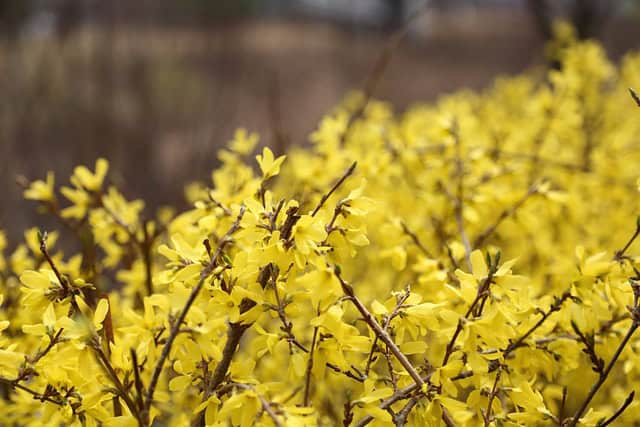
One of the first signs of spring, forsythia is celebrated for its stunning yellow blooms that often carpet the landscape with sunshine. Forsythia plants can grow between 3 to 10 feet tall, making them excellent choices for hedges or privacy screens.
These shrubs are relatively low maintenance and thrive in well-drained soil. They prefer full sun but can tolerate partial shade, making them adaptable to various garden settings. Forsythia blooms occur on old wood, so plan any pruning after flowering to promote healthy growth for the following year.
Forsythia’s vibrant yellow flowers not only bring joy to home gardens but also attract pollinators like bees early in the season, marking an important contribution to the ecosystem.
Flowering Quince (Chaenomeles Speciosa)

With its rugged branches and vibrant blossoms, flowering quince is a remarkable shrub that offers early spring color. Typically reaching heights of 3 to 5 feet, this deciduous shrub is favored for its unique, often thorny form that brings an interesting texture to landscapes.
The flowers of flowering quince are typically bright red or pink, sometimes appearing as early as February. The resulting fruit, while edible, is often tart and is better suited for preserves than raw consumption. Flowering quince is highly adaptable, tolerating various soil types and conditions; however, it flourishes in well-drained soil with full sun exposure.
Planting flowering quince along pathways or fences can create a stunning visual impact, casting bursts of color against a backdrop of lush greenery.
Korean Spice Viburnum (Viburnum Carlesii)

Korean spice viburnum, known for its stunning fragrance and stunning clusters of white to pink flowers, is a beloved addition to gardens. This deciduous shrub typically reaches heights of 4 to 6 feet and provides a breathtaking display in late spring.
The best time to enjoy its beauty is after blooming; the fragrant flowers transform into vibrant red berries that attract birds to your garden. This shrub prefers well-drained soil and can tolerate partial shade, making it a versatile choice for homeowners.
Incorporating Korean spice viburnum in your landscape not only provides visual beauty but also offers delightful aromatic notes, making your garden a sensory delight.
Witch Hazel (Hamamelis Spp.)
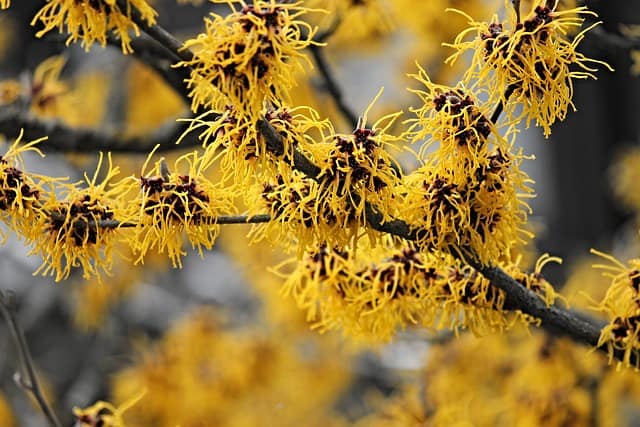
Witch hazel is a unique shrub that brings surprises throughout the year. Known for its distinctive, crinkled petals, witch hazel blooms in late winter to early spring, even before the leaves appear. The flowers, often in shades of yellow or orange, stand out against the bare branches, creating a breathtaking spectacle.
The branches of witch hazel are also known for their medicinal properties, with extracts widely used in skincare. This shrub typically grows 10 to 20 feet tall and prefers well-drained soil in full sun or partial shade. Due to its slow growth, it serves well as a feature plant in gardens.
With its striking flowers and potential health benefits, witch hazel adds a whimsical charm to the garden all year round.
Winter Daphne (Daphne Odora Spp.)
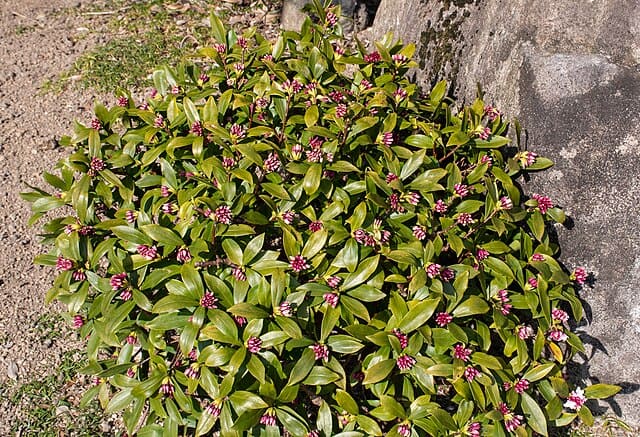
Winter daphne is a dainty evergreen shrub celebrated for its exquisite fragrance and charming white to pink clusters of flowers. Typically growing 3 to 4 feet high, it is perfect for small gardens or as part of a planting bed.
The blooms appear in winter, providing a delightful scent when few other flowers are in bloom. Winter daphne thrives in well-drained soil and prefers locations with some shelter from the wind, making it suitable for shaded areas.
Although it can be a bit finicky in terms of care, the reward is a lovely shrub that enchants virtually all who encounter its aromatic offerings.
Chinese Fringe Flower (Loropetalum Chinense)
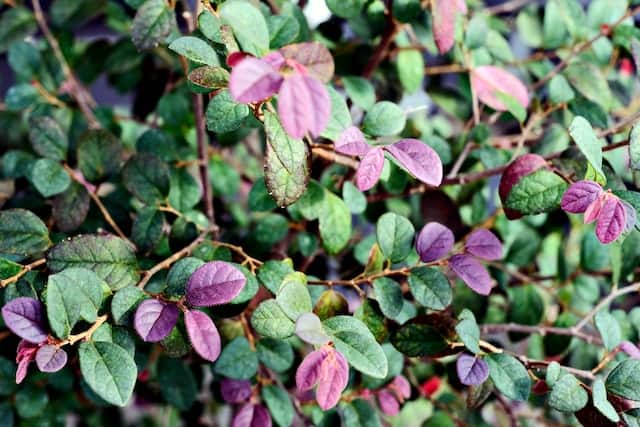
The Chinese fringe flower is known for its striking, fringe-like blooms in shades of pink and white, which create an enchanting view. This evergreen shrub typically reaches heights of 3 to 10 feet, offering flexibility for various landscape designs.
The plant’s foliage is just as impressive, featuring rich, deep green leaves or purple-tinted varieties, making it visually interesting even when not in bloom. Chinese fringe flowers thrive in well-drained soil and can tolerate both sun and shade, though they prefer a sunny location for optimal blooming.
This colorful shrub is an excellent option for adding texture and intrigue to your garden, with blooms that attract pollinators as well.
Winter Jasmine (Jasminum Nudiflorum)
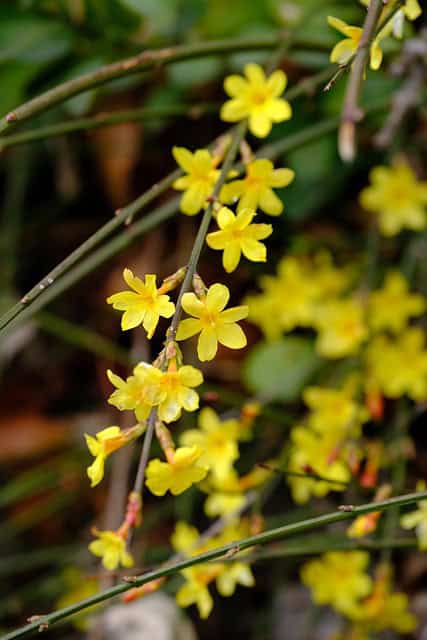
Winter jasmine is a delightful, trailing shrub that ignites the winter landscape with its cheerful yellow flowers. Reaching up to 3 feet in height, it’s often used as a ground cover or for draping over walls and containers.
Blooms appear as early as January, providing much-needed brightness during the dreary winter months. This hardy plant thrives in various soil types and prefers full sun to partial shade, ensuring adaptability in different garden settings.
The vibrant flowers of winter jasmine are a herald of spring and a joyful reminder that life continues despite the cold. Including this shrub in your garden can foster a sense of hope and cheer.
Mahonia (Mahonia Spp.)

Mahonia, often called Oregon grape, is an evergreen shrub known for its clusters of yellow flowers that bloom in late winter and early spring. The plant typically grows between 3 to 10 feet tall, providing important year-round structure and color.
In addition to its lovely blooms, mahonia features holly-like leaves that turn a beautiful hue in the fall, adding autumnal interest. After flowering, mahonia produces blue berries that attract birds and wildlife, fostering a thriving ecosystem in your backyard.
This resilient shrub thrives in various conditions but prefers shaded or partially shaded areas with well-drained soil. Integrating mahonia into your garden not only enhances its beauty but also supports local wildlife.
Lilac (Syringa Spp.)
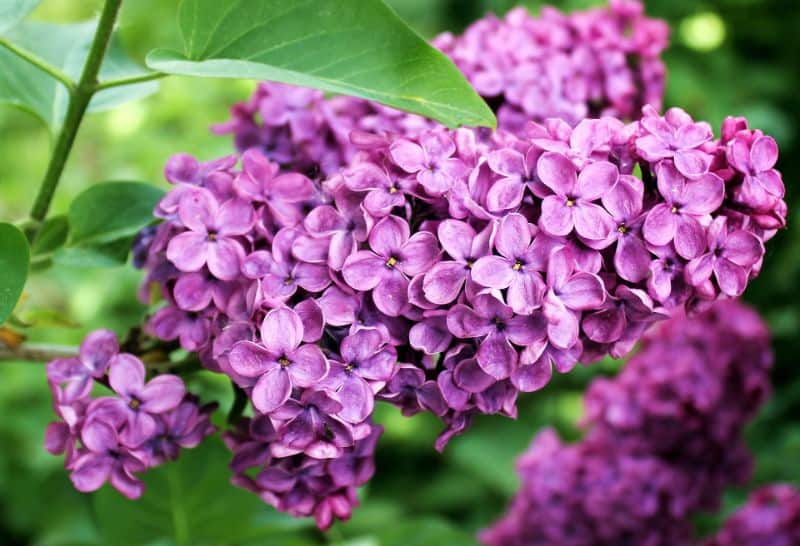
Lilacs are cherished for their fragrant flowers and iconic purple hues, marking them as a classic choice in many gardens. Reaching heights of 5 to 15 feet, their elegant blooms typically appear in spring, providing lush displays of color and aroma that beckon pollinators.
Commonly found in varieties such as the common lilac (Syringa vulgaris), these shrubs enjoy full sun with well-drained soil. Regular pruning after flowering can encourage denser growth and more abundant blooms in subsequent years.
Nothing quite compares to the enchanting scent of lilacs wafting through the garden air, making them indispensable for any floral-focused landscape.
Azalea (Rhododendron Spp.)

Azaleas are vibrant flowering shrubs that belong to the rhododendron family. Known for their striking blooms in a multitude of colors, these deciduous or evergreen shrubs reach heights of 2 to 8 feet, ideal for layering and borders.
Azaleas typically bloom in spring, adding a dazzling display of color to the landscape. They thrive in acidic, well-drained soil and prefer partial shade, making them suitable for woodlands or shaded areas of your garden.
Their popularity stems not only from their beauty but also from their low maintenance needs. Azaleas create a soft, inviting atmosphere and can fit beautifully into any garden design.
Weigela (Weigela Florida)
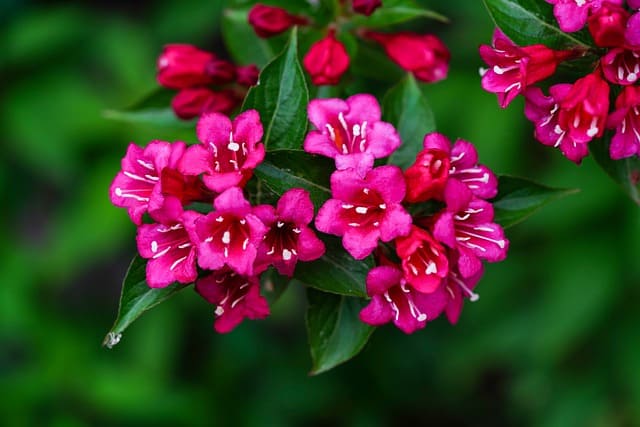
Weigela is a charming, deciduous shrub that dazzles with its trumpet-shaped flowers, available in shades of pink, red, and white. Typically growing 3 to 6 feet tall, this shrub is perfect for borders, attracting hummingbirds and butterflies.
Weigelas thrive in full sun to partial shade, flourishing in well-drained soil. Regular pruning after flowering can encourage bushier growth and improve overall aesthetics. Some cultivars provide beautiful fall foliage, adding another layer of interest.
Incorporating weigela into your garden design not only enlivens the space with color but also supports biodiversity by attracting pollinators.
Shrub Rose (Rosa Spp.)
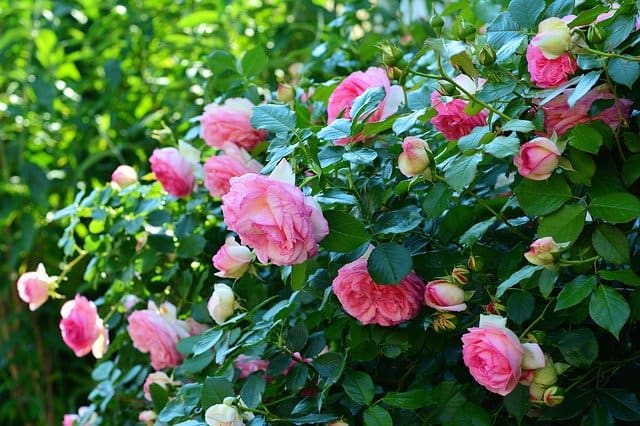
Shrub roses are versatile, hardy, and long-blooming shrubs that can enhance any garden setting. Available in a variety of colors, sizes, and fragrances, shrub roses typically reach between 3 to 5 feet tall and provide a charming presence in the landscape.
These flowers start blooming in late spring, often continuing through the frost. Shrub roses prefer full sun and well-drained soil, showcasing their resilience and adaptability. Additionally, regular deadheading encourages continuous blooming throughout the growing season.
With their vibrant blooms and appealing fragrance, shrub roses offer a timeless addition to flower gardens, combining beauty and low maintenance.
Cinquefoil (Potentilla Fruticosa)
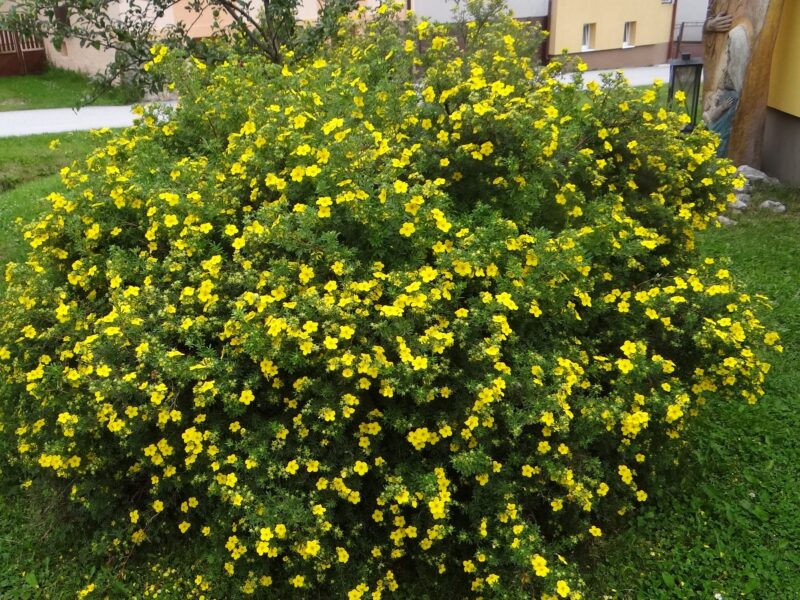
Cinquefoil is a delightful flowering shrub that boasts a long flowering season, often from late spring to fall. Reaching heights of 1 to 3 feet, this compact shrub is covered with small, five-petaled flowers that come in shades of yellow, orange, and white.
Cinquefoil thrives in well-drained soil and full sun; its drought tolerance makes it an excellent choice for more challenging conditions. The plant’s foliage offers a delicate texture, adding visual interest even when flowers aren’t in bloom.
Ideal for cottage gardens or mixed borders, cinquefoil’s low-maintenance nature and bright blooms can result in a delightful landscape that continuously evolves.
Spirea (Spiraea Spp.)

Spirea is a group of flowering shrubs known for their profuse, delicate blooms in hues of white, pink, and red. Growing 3 to 6 feet tall, spirea shrubs are often used for borders, hedges, and mass plantings, enhancing the landscape with their cascading flowers.
Blooming from late spring to early summer, spirea produces clusters of small flowers that attract pollinators while serving as a stunning backdrop with their lush foliage. Best planted in well-drained soil and full sun, regular pruning helps maintain their shape and encourages vigor.
Spirea’s versatility, ease of care, and delightful flowers make it a popular choice among gardeners.
Buttonbush (Cephalanthus Occidentalis)

Buttonbush is a unique shrub famed for its striking, round flower clusters resembling tiny pincushions. Growing between 3 to 10 feet tall, it’s often found in wetland areas, but it can easily adapt to various soil conditions.
Blooming in summer, the buttonbush flowers attract a host of pollinators, making them incredibly beneficial to wildlife. Its glossy green foliage provides an attractive backdrop, and the shrub prefers full sun to partial shade, thriving in consistently moist areas.
Integrating buttonbush into your landscape supports local biodiversity while adding an eye-catching focal point with its unusual blooms.
Summersweet (Clethra Alnifolia)
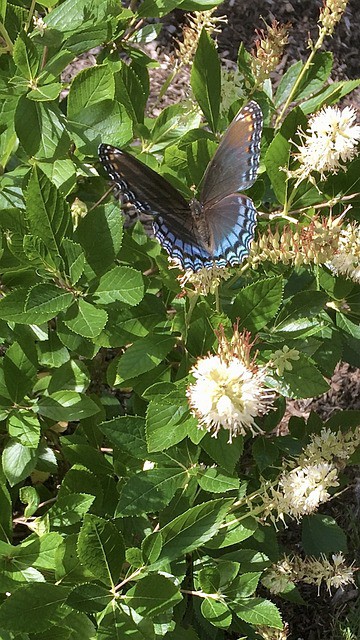
Summersweet, also known as sweet pepperbush, is a delightful deciduous shrub appreciated for its elongated flower spikes and pleasant fragrance. Typically growing between 3 to 8 feet, it provides a lovely display in mid to late summer.
This shrub thrives in moist, well-drained soil, and it’s known for its adaptability to various conditions, including both sun and shade. Summersweet’s late-season blooms attract butterflies and bees, fostering a healthier garden ecosystem.
Its sweet scent and rich green foliage make summersweet an essential addition to any flowering shrub collection.
Panicle Hydrangea (Hydrangea Paniculata)
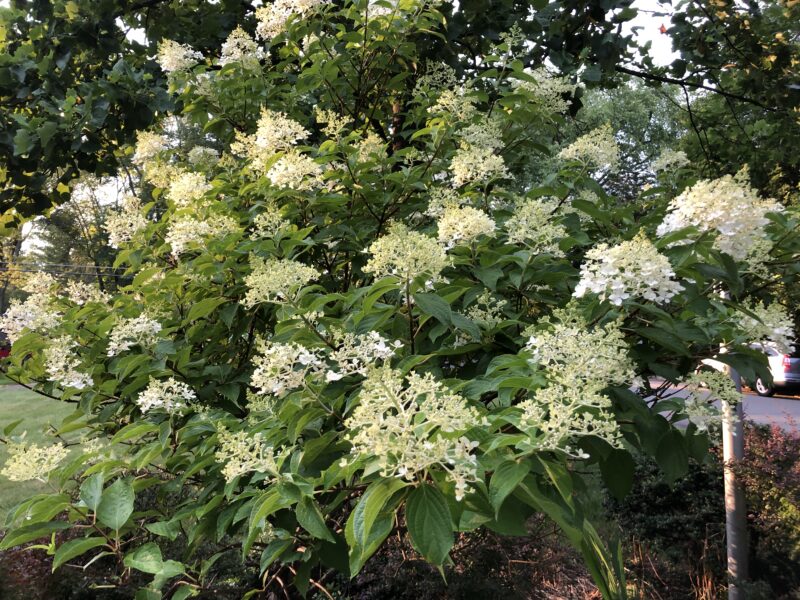
Panicle hydrangea is a hardy, deciduous shrub known for its impressive flower clusters that transition from white to pink. Growing between 4 to 8 feet tall, it adds a dramatic flair to gardens, blooming from summer into fall and providing continual visual interest.
This hydrangea type thrives in well-drained soil and full sun to partial shade, allowing gardeners to incorporate it in various settings. Its ability to tolerate pruning means it can be easily shaped and maintained for optimal size.
Panicle hydrangeas are perfect for creating focal points in your garden, and they pair beautifully with other plants, enhancing your outdoor aesthetic.
Smooth Hydrangea (Hydrangea Arborescens)

Smooth hydrangea, commonly known as Annabelle hydrangea, is another popular choice among gardeners. Characterized by its large, round flower clusters, it brings a stunning visual display to landscapes as it blooms from summer to fall.
Ranging from 3 to 5 feet in height, this shrub flourishes in well-drained soil with full sun to partial shade. The smooth hydrangea tolerates both pruning and heavy storms, making it a reliable choice for maintaining garden aesthetics.
It’s infamous for its dramatic, fluffy blooms that lend structure and content to garden beds, making smooth hydrangeas a must-have in floriferous gardens.
Deutzia (Deutzia Spp.)
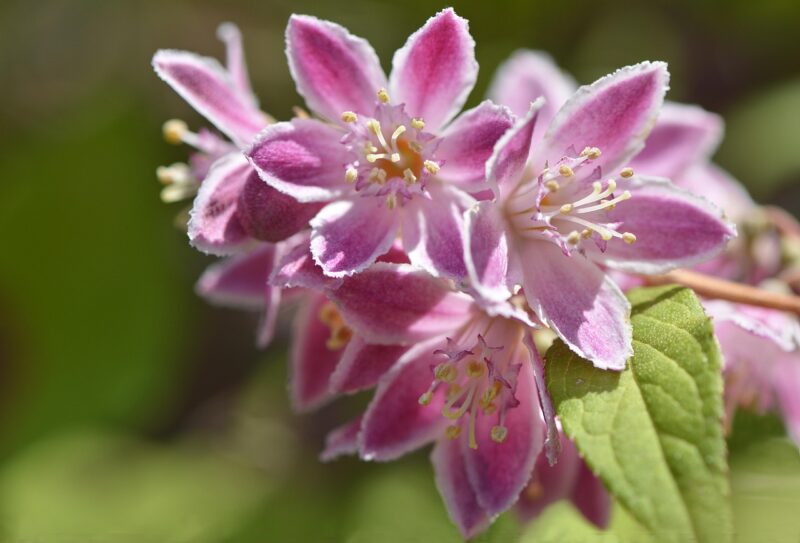
Deutzia is a delightful group of flowering shrubs known for their cascading clusters of star-like flowers. Typically growing 3 to 6 feet tall, deutzia shrubs provide a stunning display in late spring.
These deciduous plants prefer well-drained soil and thrive best in full sun, which amplifies their vibrant colors. With attractive lance-shaped leaves and moderate growth rates, deutzias are suitable for borders, hedges, or mixed gardens.
Not only do they offer beauty, but deutzias also attract hummingbirds and butterflies, further enriching the garden ecosystem.
Sweetspire (Itea Virginica)
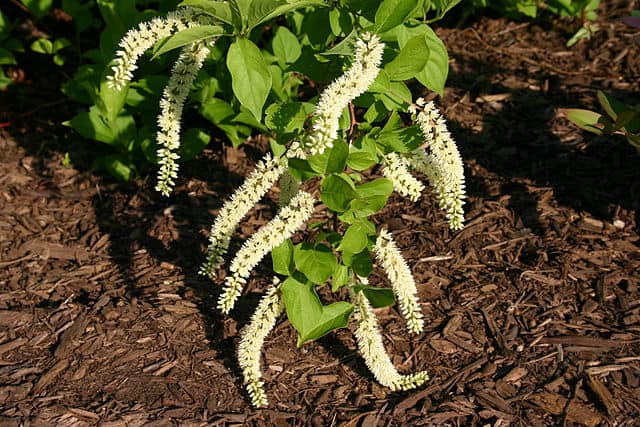
Sweetspire is a deciduous shrub known for its fragrant, raceme-like flowers that attract pollinators and add elegance to garden spaces. Growing between 3 to 6 feet tall, its cascading blooms emerge in early summer and continue into fall, enhancing its appeal.
Sweetspire thrives in various soil conditions, but it particularly appreciates moist, well-drained soil. Its vibrant fall colors create significant seasonal interest, making it a standout choice for mixed borders or naturalized areas.
Incorporating sweetspire in your landscape not only brings beauty but also provides a habitat for local pollinators.
Mock Orange (Philadelphus Spp.)
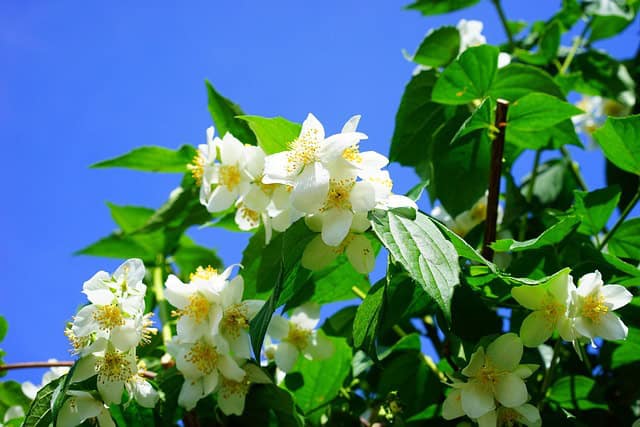
Mock orange is cherished for its citrus-scented flowers and lush green foliage. Typically growing 3 to 10 feet tall, these deciduous shrubs bloom in late spring to early summer, filling the air with their delightful fragrance.
Mock orange thrives in sunny areas with well-drained soil, making it a versatile option for many gardens. With continued pruning and care, it produces a generous display of blooms and robust growth.
The aromatic side of mock orange is a significant attraction, turning your garden into a fragrant oasis.
Smokebush (Cotinus Spp.)
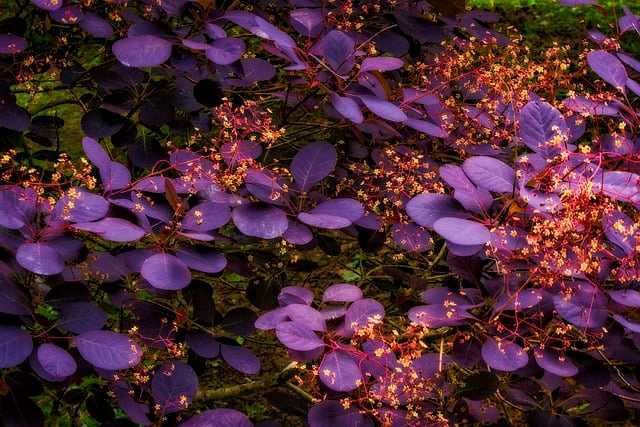
Smokebush, known for its striking appearance, features large, soft plumes that resemble puffs of smoke, typically found in shades of pink and purple. Growing between 8 to 15 feet tall, this deciduous shrub can become a stunning focal point in any garden.
Smokebush thrives in well-drained soil with full sun exposure. Its striking foliage changes colors with the seasons, showcasing deep greens in the summer and dramatic purples or reds in the fall, providing year-round interest.
Adding smokebush to your landscape creates a captivating centerpiece that enchants visitors and encourages appreciation for the beauty of nature.
Rose Of Sharon (Hibiscus Syriacus)
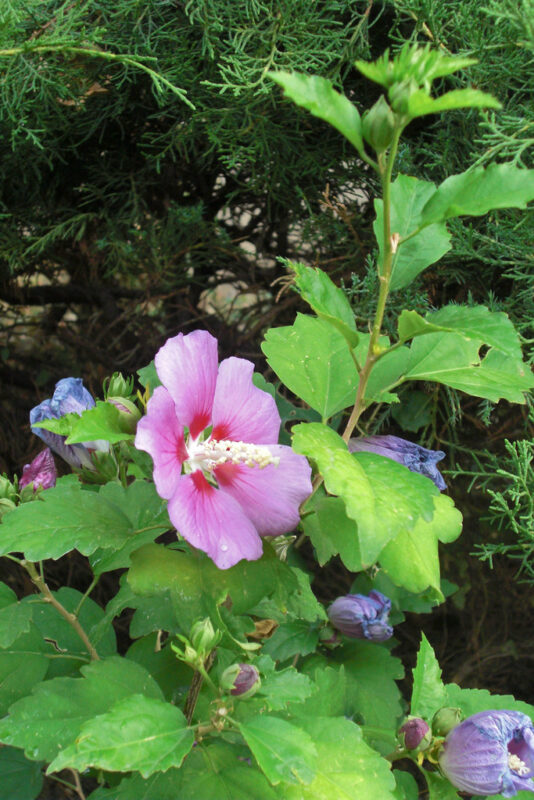
The rose of Sharon is a beautiful deciduous shrub known for its large, hibiscus-like flowers offering an exotic flair to gardens. Typically reaching heights of 6 to 12 feet, it blooms profusely during the summer, producing colorful blooms in hues of white, pink, and purple.
This hardy plant thrives in various soil types and prefers full sun, making it an excellent choice for less-than-ideal garden conditions. Rose of Sharon provides a valuable food source for pollinators during the warmer months, contributing to garden biodiversity.
Integrating rose of Sharon into your landscape provides a tropical touch that creates a welcoming oasis for both people and wildlife.
Rose Mallow (Hibiscus Moscheutos)

Rose mallow is another eye-catching shrub known for its showy, large flowers that resemble hibiscus plants. Typically growing between 3 to 5 feet tall, it produces blooms in vibrant colors, including reds, pinks, and whites, during the summer months.
This perennial prefers moist, well-drained soil and thrives in sunny locations. Its robust architecture ensures it holds attention throughout the growing season, attracting a variety of pollinators.
Rose mallow’s dramatic blooms and lush foliage promote a tropical aesthetic, effortlessly brightening your garden while fostering wildlife habitat.
Bluebeard (Caryopteris Spp.)

Bluebeard, well-known for its summer-abundant blue flowers, is a popular choice among gardeners for its resilience and beauty. Typically growing between 2 to 3 feet in height, this deciduous shrub offers a stunning display of color during its blooming cycle.
Bluebeard thrives in well-drained soil and prefers full sun exposure, making it an ideal candidate for borders, mass plantings, or garden beds. The robust growth habit and fragrant foliage attract pollinators like bees and butterflies.
Integrating bluebeard into your garden brings vibrant life and helps support local ecosystems with its bountiful color.
Abelia (Abelia Grandiflora)
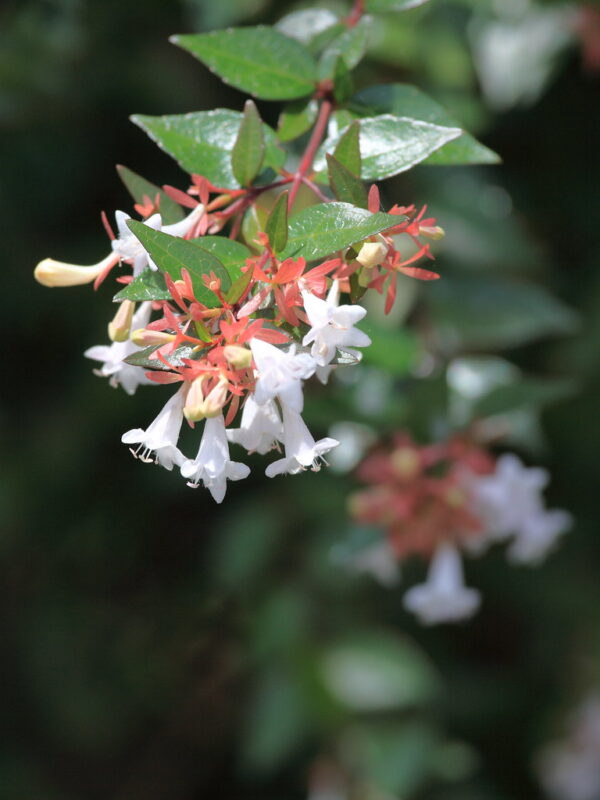
Abelia is a versatile, semi-evergreen shrub known for its fragrant white to pink flowers that bloom from summer to fall. Typically reaching heights of 3 to 6 feet, abelia can create a stunning backdrop for perennial and annual plantings.
With its attractive foliage and sweet scent, abelia thrives in well-drained soil and can tolerate varying sun exposure, yet it flourishes best in full sun. Regular pruning can help maintain its shape and promote denser growth.
This resilient shrub is an excellent choice for borders, foundation plantings, or as a specimen shrub, adding ephemeral beauty to any landscape.
Seven-Son Flower (Heptacodium Miconioides)
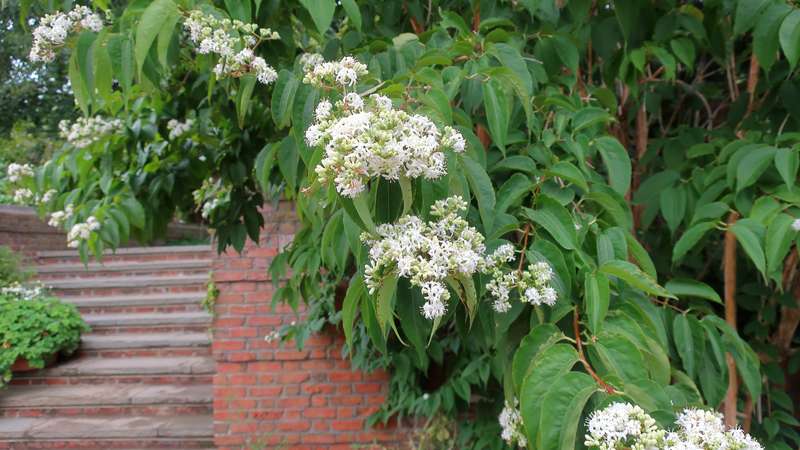
The seven-son flower is a relatively lesser-known shrub but a captivating choice for a garden feature. Typically reaching heights of 8 to 15 feet, it showcases fragrant white flowers that bloom in late summer, followed by attractive, red-hued seed capsules that persist into fall.
This adaptable shrub thrives in various soil conditions but prefers well-drained sites in full sun to partial shade. Its unique flower clusters attract pollinators and birds, providing a delightful feature year-round.
Including the seven-son flower in your landscape not only enhances its charm but also offers a space for wildlife, creating a dynamic environment.
Conclusion
Flowering shrubs provide an unparalleled beauty to gardens, offering color, texture, and fragrance throughout the seasons. From the bold hues of lilacs to the elegant blooms of winter daphne, each plant brings its charm and uniqueness to the landscape


